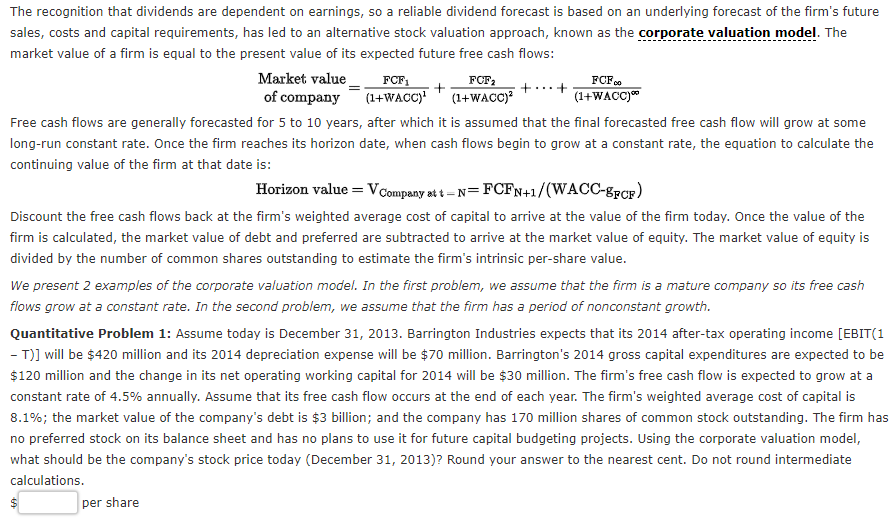

+ The recognition that dividends are dependent on earnings, so a reliable dividend forecast is based on an underlying forecast of the firm's future sales, costs and capital requirements, has led to an alternative stock valuation approach, known as the corporate valuation model. The market value of a firm is equal to the present value of its expected future free cash flows: Market value FCF + FCF FCF of company (1+WACC). *(1+WACC)* (1+WACC)" Free cash flows are generally forecasted for 5 to 10 years, after which it is assumed that the final forecasted free cash flow will grow at some long-run constant rate. Once the firm reaches its horizon date, when cash flows begin to grow at a constant rate, the equation to calculate the continuing value of the firm at that date is: Horizon value = V Company at tn=FCFN+1/(WACC-grcp) Discount the free cash flows back at the firm's weighted average cost of capital to arrive at the value of the firm today. Once the value of the firm is calculated, the market value of debt and preferred are subtracted to arrive at the market value of equity. The market value of equity is divided by the number of common shares outstanding to estimate the firm's intrinsic per-share value. We present 2 examples of the corporate valuation model. In the first problem, we assume that the firm is a mature company so its free cash flows grow at a constant rate. In the second problem, we assume that the firm has a period of nonconstant growth. Quantitative Problem 1: Assume today is December 31, 2013. Barrington Industries expects that its 2014 after-tax operating income (EBIT(1 - T)] will be $420 million and its 2014 depreciation expense will be $70 million. Barrington's 2014 gross capital expenditures are expected to be $120 million and the change in its net operating working capital for 2014 will be $30 million. The firm's free cash flow is expected to grow at a constant rate of 4.5% annually. Assume that its free cash flow occurs at the end of each year. The firm's weighted average cost of capital is 8.1%; the market value of the company's debt is $3 billion; and the company has 170 million shares of common stock outstanding. The firm has no preferred stock on its balance sheet and has no plans to use it for future capital budgeting projects. Using the corporate valuation model, what should be the company's stock price today (December 31, 2013)? Round your answer to the nearest cent. Do not round intermediate calculations. per share 1 2 3 4 5 Quantitative Problem 2: Hadley Inc. forecasts the year-end free cash flows (in millions) shown below. Year FCF - $22.67 $38 $43.5 $52.2 $55.1 The weighted average cost of capital is 12%, and the FCFs are expected to continue growing at a 4% rate after Year 5. The firm has $25 million of market value debt, but it has no preferred stock or any other outstanding claims. There are 19 million shares outstanding. What is the value of the stock price today (Year 0)? Round your answer to the nearest cent. Do not round intermediate calculations. $ per share According to the valuation models developed in this chapter, the value that an investor assigns to a share of stock is dependent on the length of time the investor plans to hold the stock. The statement above is -Select








